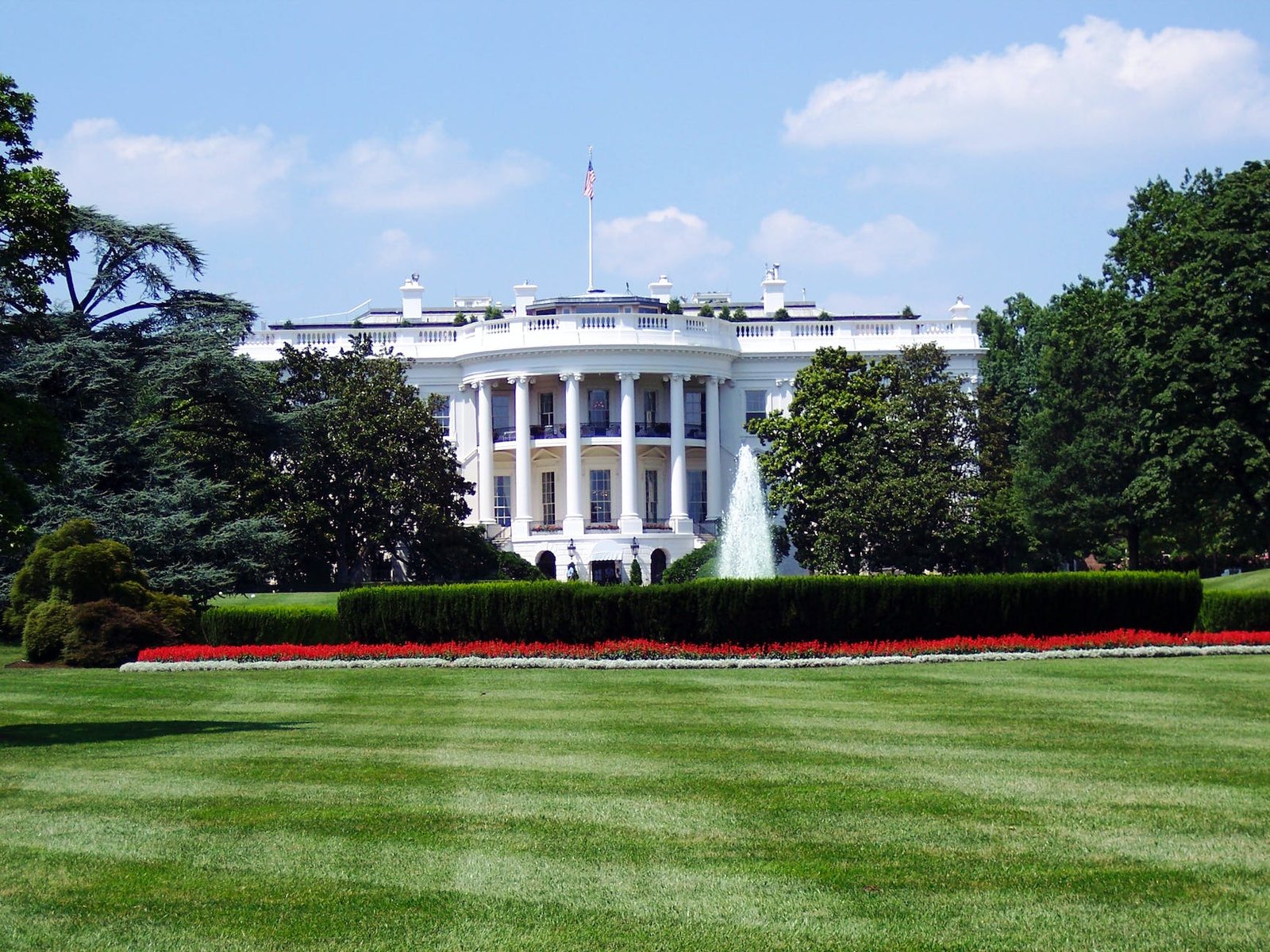The White House: The US President’s Palace

The White House is the official residence and workplace of the President of the United States, located at 1600 Pennsylvania Avenue NW in Washington, D.C. At various times in history, the White House has been known as the “President’s Palace,” the “President’s House,” and the “Executive Mansion.” It is one of the most recognizable buildings in the world and serves as the symbolic and political center of the United States government. The White House has been the residence of every U.S. president since John Adams in 1800. The building contains the Oval Office, where the president works, and other offices and meeting rooms for the president and their staff. The White House hosts several events and ceremonies, including state dinners and press conferences.
The White House has a rich and fascinating history spanning over two centuries. The construction of the White House began in 1792, during the presidency of George Washington, and was completed in 1800. The building was designed by architect James Hoban, who was inspired by the Leinster House in Dublin, Ireland.
The original White House was much smaller than the current building, consisting of just the central section. It was expanded in the early 19th century with the addition of the East and West Wings, which were designed by Benjamin Latrobe.
The White House has been renovated and updated several times over the years, with the most extensive renovations taking place during the Truman and Kennedy administrations. In the 20th century, the White House underwent major renovations to modernize its infrastructure and increase its security measures.
The White House is also home to many historic moments in American history. It has hosted numerous state dinners, presidential inaugurations, and other important events, including the signing of the Emancipation Proclamation by President Abraham Lincoln in 1862.
Today, the White House remains an important symbol of American democracy and serves as the official residence and workplace of the President of the United States.
The White House is a neoclassical-style building that is constructed of sandstone painted white. The building is rectangular and has four levels, including the basement.
The main section of the White House is known as the Residence and consists of several rooms, including the Oval Office, the Lincoln Bedroom, and the State Dining Room. The East and West Wings were added to the building in the early 19th century and contain additional rooms, including the Cabinet Room and the Situation Room.
The exterior of the White House features numerous columns and a large portico at the entrance. The building is topped with a white-painted wooden balustrade and a hipped roof. The building’s facade is symmetrically balanced, with windows arranged in rows and columns.
The White House also features numerous gardens and grounds, including the famous Rose Garden and the South Lawn. The grounds are beautifully landscaped and provide a scenic setting for official events and ceremonies.
Overall, the architectural structure of the White House is designed to convey a sense of grandeur and elegance, while also serving as a functional workplace for the President and their staff.
The security of the White House is of paramount importance, given its role as the residence and workplace of the President of the United States. The White House is protected by multiple layers of security, including physical barriers, personnel, and technology.
One of the most visible security features of the White House is the fence that surrounds the perimeter of the property. The fence is approximately seven feet tall and is made of wrought iron. It is also equipped with various sensors and cameras that can detect and deter potential intruders.
The White House is also protected by a highly trained security force, including the United States Secret Service, which is responsible for the safety and security of the President and their family. The Secret Service is supported by other law enforcement agencies, including the FBI and the Department of Homeland Security.
In addition to physical security measures, the White House is also protected by advanced technology, including surveillance cameras, motion detectors, and other sensors. The building is also equipped with sophisticated communication systems that allow for rapid response to any security threats.
Overall, the security of the White House is a top priority for the U.S. government, and extensive measures are taken to ensure the safety and protection of the President and their staff.
The total staff of the White House varies depending on the administration and the needs of the President. However, in general, the White House employs several hundred staff members across a range of departments and offices.
Some of the key departments and offices within the White House include:
- The Executive Office of the President (EOP): This is the largest department within the White House and includes a range of offices and agencies, including the National Security Council, the Council of Economic Advisors, and the Office of Management and Budget.
- The White House Office: This is the office of the President and includes their closest advisors and staff members, including the Chief of Staff, the Press Secretary, and the Counsel to the President.
- The Office of the Vice President: This office supports the Vice President and includes staff members who work on policy, communications, and scheduling.
- The East Wing: This area of the White House includes the First Lady’s office and staff, as well as the White House Social Secretary and their staff.
The daily expenses of the White House can vary depending on several factors. According to public records, the White House’s annual budget for the 2021 fiscal year was approximately $712 million. This budget covers a range of expenses, including staff salaries, maintenance and repairs, utilities, travel, and supplies.
Some of the specific expenses that are associated with the daily operation of the White House include:
- Staff salaries: The White House employs several hundred staff members, including advisors, administrative personnel, and support staff. The salaries of these staff members are a significant portion of the overall budget.
- Maintenance and repairs: The White House is a historic building that requires regular maintenance and repairs to keep it in good condition. This can include everything from painting and cleaning to more extensive renovations and upgrades.
- Utilities: The White House uses a significant amount of electricity, water, and other utilities daily, which can result in substantial expenses.
- Travel: The President and their staff often travel for official business, both domestically and internationally. This can include expenses such as airfare, lodging, and transportation.
The White House follows several protocols that are designed to ensure that the President and their staff can effectively carry out their duties and responsibilities. Some of the key protocols of the White House include:
- Security protocol: As the residence and workplace of the President of the United States, the White House is subject to strict security protocols designed to protect the President and their staff. This includes everything from physical security measures to background checks for personnel.
- Communication protocol: The White House has a well-established communication protocol that governs how information is shared between the President, their staff, and the media. This includes guidelines for press conferences, briefings, and other forms of communication.
- The White House follows diplomatic protocol when interacting with foreign leaders and dignitaries. This includes protocols for hosting state dinners, formal meetings, and other diplomatic events.
- Protocol for handling classified information: The White House follows strict protocols for handling classified information, designed to ensure that sensitive data is protected and kept confidential.
- Protocol for handling crises: The White House has established protocols for handling crises, such as natural disasters, terrorist attacks, or other emergencies. These protocols are designed to ensure that the President and their staff can effectively respond to crises and protect the safety and well-being of the American people.
The White House is one of the most heavily guarded and secure buildings in the world due to the high level of risk it faces. The risks to the White House can come from a variety of sources, including:
- Terrorism: The White House is a prominent symbol of the United States government and its policies, making it a potential target for terrorists.
- Civil unrest: Protests and demonstrations are a common occurrence in Washington, D.C., and the White House is often the site of such events. These protests can sometimes turn violent, posing a risk to the safety of the building and its occupants.
- Cyberattacks: The White House is also at risk of cyberattacks, which could compromise sensitive information or disrupt important systems.
- Natural disasters: The White House is located in an area that is vulnerable to natural disasters such as hurricanes, tornadoes, and earthquakes.
To mitigate these risks, the White House has some security measures in place, including:
- Physical barriers: The White House is surrounded by several layers of physical barriers, including fences, walls, and checkpoints.
- Security personnel: The White House has a large security force, including Secret Service agents, that is responsible for protecting the building and its occupants.
- Technology: The White House uses a range of advanced technologies, such as surveillance cameras and biometric scanners, to enhance its security.
- Emergency preparedness: The White House has plans in place to respond to a variety of emergencies, including natural disasters, terrorist attacks, and cyberattacks.
The White House welcomes visitors from the general public on a limited basis. There are several ways for common citizens to visit the White House, including:
- White House tours: The White House offers tours to the public, which provide visitors with the opportunity to see the historic building and learn about its history and significance. However, these tours must be arranged in advance and require a reservation through a member of Congress.
- Special events: The White House occasionally hosts special events that are open to the public, such as the Easter Egg Roll or the National Christmas Tree Lighting. These events typically require tickets, which can be obtained through a lottery system or other means.
- Public access areas: Some public areas of the White House can be visited without reservation or ticket. For example, the White House Visitor Center is open to the public and offers exhibits, videos, and other educational resources.
- Online resources: The White House website offers a range of online resources for visitors, including virtual tours, historical information, and other educational resources.
It is important to note that visiting the White House can be a complex process and requires advanced planning and coordination. Visitors must go through a security screening process and follow strict guidelines during their visit. Additionally, certain areas of the White House may be off-limits to visitors, depending on the President’s schedule and other factors.
So, you must plan to visit the White House, Washington, D.C. one visit to the USA.

